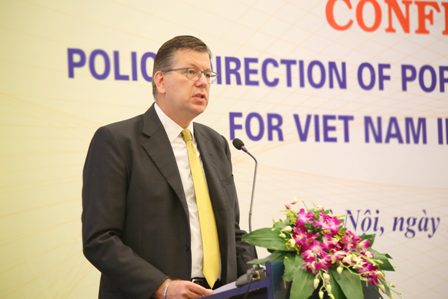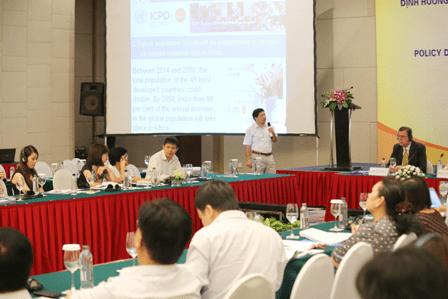HA NOI, 15 August 2014 – Viet Nam has achieved middle-income country status in 2010 and has continued to sustain impressive growth rates, as a result, is on track to achieve most of the MDG targets by 2015. However, wide disparities between urban and rural areas, among geographical areas, and population groups still exist.
Data from the 2009 census and other population based surveys show that Viet Nam has made impressive progress in achieving its population goals. The average Vietnamese woman now gets just two children in her lifetime. That means that Viet Nam has reached replacement level fertility, many years earlier than the Politburo's target set in the Resolution 47-NQ/TW on "Strengthening the implementation of the population and family planning policies" issued on 22 March 2005. Reductions in maternal and child mortality have been also impressive. However, progress made at the national level also masks disparities at the sub-national level. Inequalities and disparities have been increasing and are accompanied by new forms of poverty and vulnerability that will require greater attention in the coming years.
Therefore, the population policy should link population to overall development strategies, rather than narrowly focusing on fertility. The new population law must develop a legal basis for the integration of population variables into all development policies and sectoral planning to ensure that the needs of different population groups, particularly vulnerable groups, to be addressed in all development sectors, emphasized by the leaders of the Central Committee for Propaganda and Education (CCPE) and the United Nations Population Fund (UNFPA) in Viet Nam at the Conference held today in Ha Noi.
Addressing the Conference, Mr. Pham Van Linh, Vice Chairman of the CCPE noted: "In order to address the challenges on population issue, it's necessary to adjust the population law and policies in the coming years to meet the needs of the new context. In 2015, the CCPE will review the ten year implementation of the Resolution 47-NQ/TW on "strengthening the implementation of the population and family planning policies" issue on 22 March 2015 by the Politburo and will request the Politburo and Central Party Committee to provide guidance on developing appropriate laws and policies on population contributing to the industrialization and modernization of the country".

Viet Nam is developing a new Population Law to demonstrate the policy direction in the new phase taking into account lessons learnt and experiences from the implementation of the Population Ordinance as well as lessons learned from other countries. "The new Population Law is an excellent opportunity for Viet Nam to highlight the consistency between the Constitution and laws, and elaborate the commitment to ICPD into enforceable legal provisions, that is to protect and fulfill the rights of couples and individuals to have free and responsible decision on reproduction," said Mr. Arthur Erken, UNFPA Representative in Viet Nam at the conference.
During the conference, the General Director of the General Office for Population and Family Planning (GOPFP) reported on the outcomes of the 47th session of the Commission on Population and Development and a national researcher presented on the needs for Viet Nam to shift from population and family planning to population and development. These presentations helped facilitate active discussions among participants on how to ensure that the new Population Law of Viet Nam will be a well-informed law that will respond to the opportunities and challenges of population dynamics, as well as the aspirations and desires of the Vietnamese people.
Click here to read the UNFPA Representative's speech at the conference


